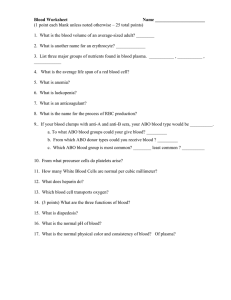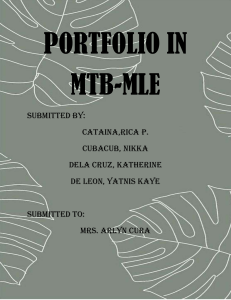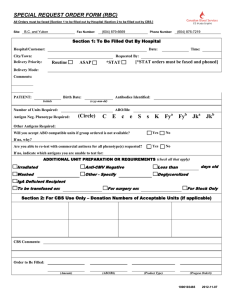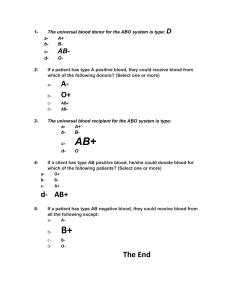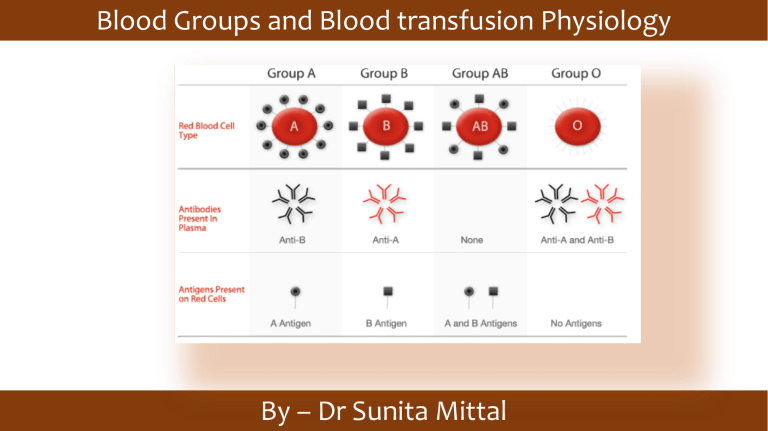
Blood Groups and Blood transfusion Physiology By – Dr Sunita Mittal Learning Objectives ▪ABO and Rh systems and their clinical significance. ▪Incompatibilities in Rh systems ▪Blood transfusions - basis of blood typing, Cross matching ▪Complications of Blood transfusions (transfusion reactions) ABO blood group system ▫First ever blood transfusion was made dog to dog by British physician Richard Lower in 1665. ▫Austrian immunologist Karl Landsteiner discovered the ABO blood group System in 1901. In 1910 he won Nobel prize for medicine for this discovery. In 1940- Karl Landsteiner and Alexander S Wiener reported another Rh blood group. Importance of knowing about blood group system 1. Safe blood transfusion that may be life saving. 2. To prevent hemolytic disease of new born (Rh compatibility in newborn) 3. To solve the legal disputes related to parenting claimant. 4. To study the Mendelian laws of genetics. ABO blood group system The ABO blood group antigens are complex oligosaccharide chains that differ in their terminal sugar and project above the RBC surface. following types of abs may develop- type A: anti-B abs, type B: anti-A abs, type O : both & type AB: neither. Landsteiner’s Law 1. If a certain agglutinogen is present on the surface of RBCs, the corresponding agglutinin must be absent in the plasma. 2. If a certain agglutinogen is absent on the surface of RBCs, then corresponding agglutinin must be present in the plasma. ABO blood group system- Relative frequency ABO blood types Relative frequency of different blood types: • O 47% • A 41% • B 09% • AB 3% (World) Inheritance of ABO blood group system ▪The ABO locus has three main allele forms: A, B, & O. The A and B genes found on chromosome 9 and are inherited one gene (allele) from father and one from mother. 1.Homozygous A Genotype A/A Phenotype A 2. Heterozygous A Genotype A/0 Phenotype A Inheritance of ABO blood group system Basic Precursor Substance L-Fucosyl Transferase Presence of H H / Hh gene H substance/Ag A gene N-acetylgalactosaminyl Transferase A & H – Ag Blood Group A ▪ B gene D-galactosyl Transferase B & H – Ag Blood Group B None of A & B genes H – Ag Blood Group O Universal Donor and Recipient / ABO blood group Universal Donor : O-ve and Universal Recipient AB+ve Rh blood group system ▪The Rh factor, named for the rhesus monkey because it was first studied using the blood of this animal. ▪85% of whites are D-positive & 15% are D-negative; over 99% of Asians are D-positive. ▪Unlike the ABO antigens, the system has not been detected in tissues other than red cells. Hemolytic disease of the newborn (Erythroblastosis Fetalis) 1. Hydrops fetalis-baby may die in utero. 2. Erythroblastosis fetalis 3. If mother has received anti D abs injection at time of Ist delivery, this causes neutralization of baby’s Rh+ve RBCs, and immune system does not activate to produce abs. Hemolytic disease of the newborn –Indirect Coomb’s Test Self Assessment Austrian immunologist Karl Landsteiner discovered the ................... System in 1901. In 1940- Karl Landsteiner and Alexander S Wiener reported ……………………………… The ABO blood group antigens are attached to …………………chains that differ in their terminal sugar If a certain agglutinogen is ……on the surface of RBCs, then corresponding agglutinin must be … in plasma. The ……and its allele h are inherited independently of the allels A, B and O genes. If mother has received anti D abs injection at time of Ist delivery, this causes neutralization of baby’s ………. and immune system does not activate to produce abs. Thank you
